The things I’ve made most recently are all media: three videos and two articles for this week’s Reader, to be precise. (Kate Schmidt, the food editor, joked that this week would be the special Michael Gebert issue.) So as far as blogging here goes, I’m just going to cover it off with a few pics of things I made to eat at home around the holidays:
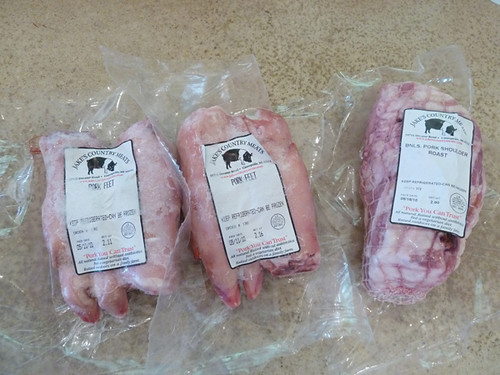
1. Pork Head & Parsley Pate, from Pork & Sons.
When I reviewed James Villas’ Pig a few weeks back, Mark S., who blogs about charcuterie here (and is Msmre on LTHForum), mentioned the book Pork & Sons as his favorite of the current crop of porky books, so I added it to my Amazon wish list just in time for my birthday. I have to admit that until then, I had overlooked it purely because of its pink gingham cover. A French import, it’s kind of the Amelie of French meat books, awfully pleased with how cute and quaint and Fffronsh it is. Still, it does indeed seem solid and evocative of a certain style of eating worth preserving.
Wanting something for a Christmas dinner starter, I decided to make this pate— really, a headcheese. I contacted the Jake’s Country Meats folks, who sell at the Logan Square Farmer’s Market, and asked for whatever they had of the cuts the recipe listed: a head, two trotters, and some shoulder. Well, they were all out of head, but I got the trotters and the shoulder, diced up the appropriate amount of the latter, and set it to cooking with some aromatics and vegetables:
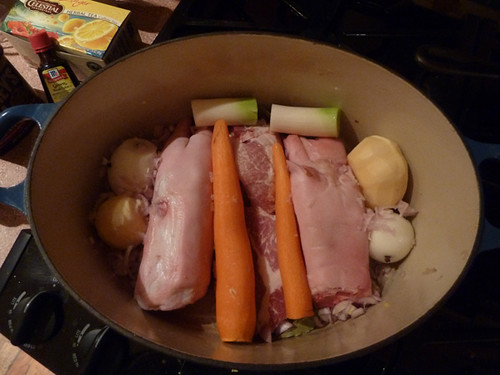
One thing to note about pig’s feet— there’s no meat on them. I don’t mean “hardly any,” I mean zero— all you get from them is the gelatin. The meat was all from the shoulder. When reduced to tender chunks, I diced it up and laid it in the terrine:
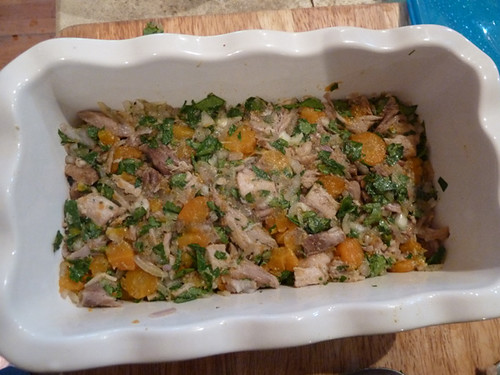
One thing I remember Rob Levitt said when he was demonstrating making testa was that you should salt and season it heavily, since it will be eaten cold. Meanwhile I reduced the gelatinous broth to a truly shimmery thickness, and poured it over the packed meats and vegetables:
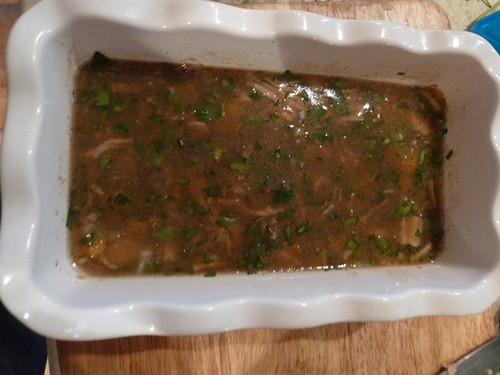
A couple of days to set in the fridge, and:
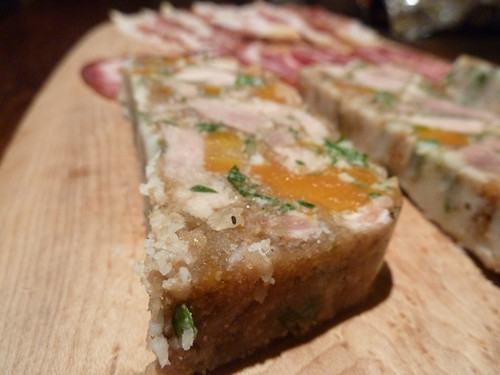
I really liked this pate, it’s full of flavor (and not just meat, either), though I think I need to buy a smaller terrine for such exercises— I’m the only one who eats this stuff, generally, and it didn’t get completely finished, sad to say.
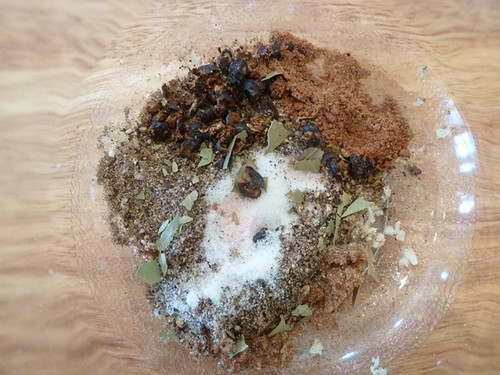
2. Pancetta, from Charcuterie.
At the same time I got three decent-sized strips of pork belly from Jake’s. Two were destined to be bacon, but I decided to experiment with pancetta with the other, having loved my pancetta from Bolzano Artisan Meats in Milwaukee. I mixed up the spices and curing salts, coated the belly and sealed it away for a week…
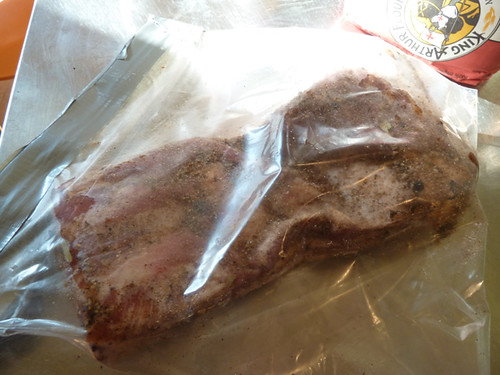
After a week I cleaned it off and cut it in half. I wrapped the pieces in cheesecloth and hung them in my wine fridge:

A week after that I took one piece out to try some and use it on a pizza. The meat had only lost about 10% of its weight, and what I realized was, although this soft, supple meat had the texture of most pancetta you buy, and tasted fine, I really preferred Bolzano’s, which I suspect is both more heavily salted and more aggressively dried. So I’m going to try drying at least one piece more, even at the risk of spoilage, and see if I get closer to what I liked about theirs. If it goes bad, well, I learned something.

3. Great Grandma’s Suet Pudding, Marjorie Zalewski, Toledo, Ohio (3rd Place, Ohio State Fair Family Heirloom Recipes Competition)
I was of a mind to make a traditional Christmas pudding this year. Cathy Lambrecht mentioned that she had posted one that had won a prize in a contest at the Ohio State Fair at the Greater Midwest Foodways Alliance site.
With such simple beginnings do many epic sagas start.
The recipe looked like just the thing— old-fashioned flavors like molasses, suet as the primary fat, and so on— so, being of a mind to get whatever I could out of the way before the big day, I mixed it up (making cranberry relish at the same time on the top of the stove), grated the suet myself from some beef fat I’d bought at Paulina Meat Market, and baked it in a bain-marie for three hours. At the end of which, opening the Jiffy Pop-like aluminum tent, I found that it was… flat. Very flat.
I studied the recipe for clues. It didn’t take long: carelessly I had used baking powder where more inflationary baking soda was called for. It was now about eight o’clock on Friday night. If I hurried and actually paid attention this time, I could just get a second one baked by midnight. This is how I spend Friday nights, folks.
The second one went in. Meanwhile, I tasted the first. It tasted… authentic. With nothing but molasses for sweetener, it was very 19th century, very hardscrabble life on the Plains. It tasted like Christmas… in a Willa Cather novel.
I decided I couldn’t end Christmas dinner with a dessert that no one liked. Notably, my children. So the next morning I started making an apple-lemon curd dessert with Sauternes— if the first dessert was Willa Cather, this one was Schnitzler, Toulouse-Lautrec, Debussy, Continental elegance with a touch of the dandy and of the decadent.
Christmas dinner came. I advised my guests that no one would take it amiss if they had one bite of the prairie dessert and then devoured the other. But, in fact, Grandma Zalewski had a trick up her sleeve— it may not have been the case in 1840, but by the 20th century when she was passing this one down, it came with a brandy hard sauce full of sugar, which lightened and leavened the dense, molasses-y darkness of the pudding. It was still substantive, but no longer ponderous. The clash of dessert worlds became a fair fight, and in fact, both were eaten with considerable pleasure (not to mention the rest of the Sauternes). In the end, Cather and Schnitzler together produced a last course out of Dickens, leaving us full and full of good fellowship. It’s important to know how to keep Christmas, after all. Ask a famous author.


 If you like this post and would like to receive updates from this blog, please subscribe our feed.
If you like this post and would like to receive updates from this blog, please subscribe our feed.




